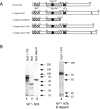Dcp2 Decaps m2,2,7GpppN-capped RNAs, and its activity is sequence and context dependent
- PMID: 16199859
- PMCID: PMC1265788
- DOI: 10.1128/MCB.25.20.8779-8791.2005
Dcp2 Decaps m2,2,7GpppN-capped RNAs, and its activity is sequence and context dependent
Abstract
Hydrolysis of the mRNA cap plays a pivotal role in initiating and completing mRNA turnover. In nematodes, mRNA metabolism and cap-interacting proteins must deal with two populations of mRNAs, spliced leader trans-spliced mRNAs with a trimethylguanosine cap and non-trans-spliced mRNAs with a monomethylguanosine cap. We describe here the characterization of nematode Dcp1 and Dcp2 proteins. Dcp1 was inactive in vitro on both free cap and capped RNA and did not significantly enhance Dcp2 activity. Nematode Dcp2 is an RNA-decapping protein that does not bind cap and is not inhibited by cap analogs but is effectively inhibited by competing RNA irrespective of RNA sequence and cap. Nematode Dcp2 activity is influenced by both 5' end sequence and its context. The trans-spliced leader sequence on mRNAs reduces Dcp2 activity approximately 10-fold, suggesting that 5'-to-3' turnover of trans-spliced RNAs may be regulated. Nematode Dcp2 decaps both m(7)GpppG- and m(2,2,7)GpppG-capped RNAs. Surprisingly, both budding yeast and human Dcp2 are also active on m(2,2,7)GpppG-capped RNAs. Overall, the data suggest that Dcp2 activity can be influenced by both sequence and context and that Dcp2 may contribute to gene regulation in multiple RNA pathways, including monomethyl- and trimethylguanosine-capped RNAs.
Figures







Similar articles
-
Nematode m7GpppG and m3(2,2,7)GpppG decapping: activities in Ascaris embryos and characterization of C. elegans scavenger DcpS.RNA. 2004 Oct;10(10):1609-24. doi: 10.1261/rna.7690504. RNA. 2004. PMID: 15383679 Free PMC article.
-
Contribution of trans-splicing, 5' -leader length, cap-poly(A) synergism, and initiation factors to nematode translation in an Ascaris suum embryo cell-free system.J Biol Chem. 2004 Oct 29;279(44):45573-85. doi: 10.1074/jbc.M407475200. Epub 2004 Aug 20. J Biol Chem. 2004. PMID: 15322127
-
In vivo translation and stability of trans-spliced mRNAs in nematode embryos.Mol Biochem Parasitol. 2007 Jun;153(2):95-106. doi: 10.1016/j.molbiopara.2007.02.003. Epub 2007 Feb 21. Mol Biochem Parasitol. 2007. PMID: 17391777 Free PMC article.
-
RNA decapping inside and outside of processing bodies.Curr Opin Cell Biol. 2005 Jun;17(3):326-31. doi: 10.1016/j.ceb.2005.04.002. Curr Opin Cell Biol. 2005. PMID: 15901504 Review.
-
New insights into the control of mRNA decapping.Trends Biochem Sci. 2006 May;31(5):241-3. doi: 10.1016/j.tibs.2006.03.001. Epub 2006 Mar 31. Trends Biochem Sci. 2006. PMID: 16580207 Review.
Cited by
-
Mutational analysis of a Dcp2-binding element reveals general enhancement of decapping by 5'-end stem-loop structures.Nucleic Acids Res. 2009 Apr;37(7):2227-37. doi: 10.1093/nar/gkp087. Epub 2009 Feb 20. Nucleic Acids Res. 2009. PMID: 19233875 Free PMC article.
-
The messenger RNA decapping and recapping pathway in Trypanosoma.Proc Natl Acad Sci U S A. 2015 Jun 2;112(22):6967-72. doi: 10.1073/pnas.1424909112. Epub 2015 May 18. Proc Natl Acad Sci U S A. 2015. PMID: 26038549 Free PMC article.
-
C. elegans La-related protein, LARP-1, localizes to germline P bodies and attenuates Ras-MAPK signaling during oogenesis.RNA. 2008 Jul;14(7):1378-89. doi: 10.1261/rna.1066008. Epub 2008 May 30. RNA. 2008. PMID: 18515547 Free PMC article.
-
Global Profiling of Cellular Substrates of Human Dcp2.Biochemistry. 2020 Nov 3;59(43):4176-4188. doi: 10.1021/acs.biochem.0c00069. Epub 2020 May 14. Biochemistry. 2020. PMID: 32365300 Free PMC article.
-
Global analysis of uncapped mRNA changes under drought stress and microRNA-dependent endonucleolytic cleavages in foxtail millet.BMC Plant Biol. 2015 Oct 6;15:241. doi: 10.1186/s12870-015-0632-0. BMC Plant Biol. 2015. PMID: 26444665 Free PMC article.
References
-
- Baker, K. E., and R. Parker. 2004. Nonsense-mediated mRNA decay: terminating erroneous gene expression. Curr. Opin. Cell Biol. 16:293-299. - PubMed
-
- Beelman, C. A., A. Stevens, G. Caponigro, T. E. LaGrandeur, L. Hatfield, D. M. Fortner, and R. Parker. 1996. An essential component of the decapping enzyme required for normal rates of mRNA turnover. Nature 382:642-646. - PubMed
-
- Blumenthal, T. 1995. Trans-splicing and polycistronic transcription in Caenorhabditis elegans. Trends Genet. 11:132-136. - PubMed
Publication types
MeSH terms
Substances
Associated data
- Actions
Grants and funding
LinkOut - more resources
Full Text Sources
Other Literature Sources
Molecular Biology Databases
Miscellaneous
